Volkswagen has an enviable product in the GTI. Based around the already-desirable Golf, with the addition of sleek styling and purposeful power, the GTI is one of the most eagerly anticipated cars of the year. Europe has been banging on about it for months, Louisson raved about it after hustling it around a wet Paul Ricard, and now it’s my turn to try it out over NZ blacktop. Brought along for comparison is its evenly priced European rival, the Renault Mégane RS225. The Mégane packs more power: the GTI the better ‘on paper’ chassis. With turbo’d four-pots and only the front wheels driven, it’s a hot-hatch shoot-out destined to produce plenty of smoke.
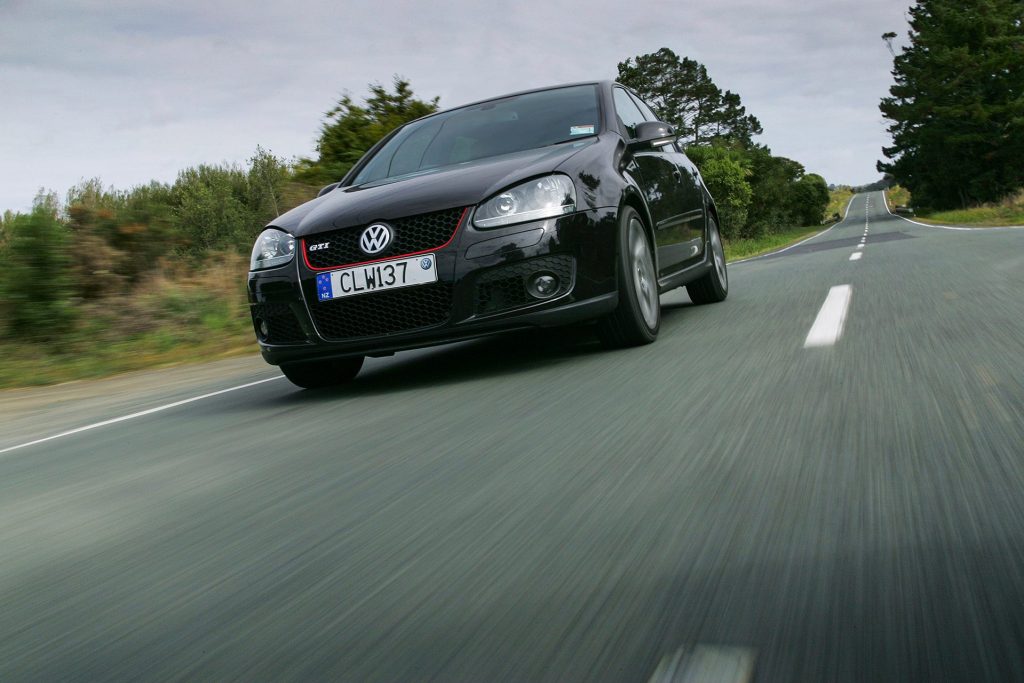
Price/Equipment
Both come well loaded with equipment. Suitable for the top dogs of their respective ranges, there’s the full leather interior, climate air (dual zone in the Dubbie), cruise and electrics. Safety status is equal: both cars have five Euro NCAP stars. There are six airbags apiece, and both have ABS/EBD and ESP systems to reign in traction losses and sideways slides. Neither has a great audio system but both will let you shuffle through six CDs. Renault adds in rain-sensing wipers and auto Xenon headlights, but otherwise the cars are evenly specified.
Adding some spice to both packages are sports seats, particularly in the Golf. Not only are these superbly shaped and supportive but look the biz. Special gauges set off the dashes and the Golf’s sawn-off steering wheel is a work of art – a suitably dramatic tool with which to control the GTI.
Cost has them squaring up evenly. The manual-only Renault sits with a price of $49,990, identical to the six-speed manual GTI. Those who like a hand free can opt for a DSG-equipped GTI for an extra $3000.
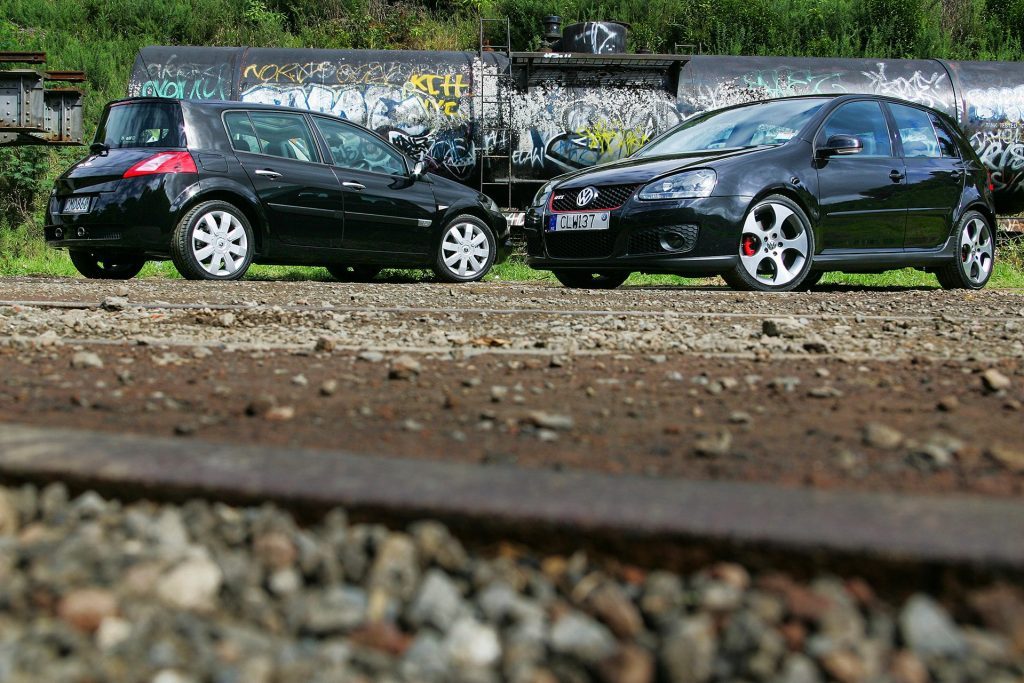
Design/Engineering
Renault slots a powerful turbocharged 2.0 litre into the fashionably styled Mégane to create the RS 225. The borrowed Vel Satis turbo mill gets the added durability of strengthened rods, pistons, a new crank and a larger intercooler. The resulting 165kW and 300Nm at 3000rpm make it the grunter of this duo. Tractable from 2500rpm, the engine pulls hard through its torque-laden midrange to its peak power at 5500rpm. It’s the more vocal of the two, complete with turbo-inspired whistles and flutters, and works through a six-speed gearbox sending power to the front wheels. Renault has fiddled dramatically with the front-end set-up to sort out the torque steer. It’s done a decent job, but under full power, the RS225 will start to wander sideways and struggles with traction. Effort has also been made to sharpen the dynamics, with wider tracks, a lower ride height and firmer springs than its donor car. A dynamically limiting factor of the RS 225 is its low-tech torsion-beam rear axle. There are 17-inch Renault Sport alloys wrapped in 225 cross-section Michelin rubber, and Brembos are assigned to arrest speed.
The GTI shares the suspension basics with the rest of the Golf range: Mac struts under the front guards and the new multilink rear, making this the first GTI to have an independent rear-end. Adding to the GTI mix is a ride-height reduction, firmer suspension and larger-diameter sway bars. Rolling stock is also improved, the telephone-dial design making a 21st Century return. Measuring 18 inches, they hide the GTI-specific brake package with 312mm brake rotors on the front.
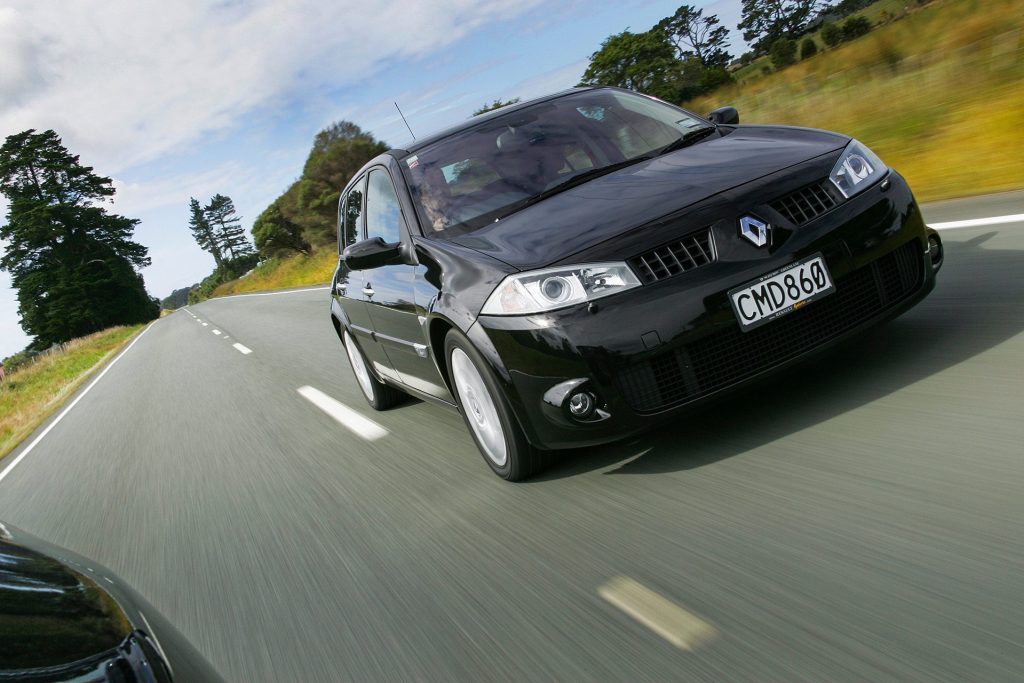
Electromechanical steering remains in both, a concession to cost and fuel-saving. But the Golf’s gets remapped to provide more weighting and a quicker response. The RS225 has variable, speed-sensitive assistance.
Both go without the all-important LSD, as it’s cheaper now for manufacturers to rig the electronics to handle mid-corner wheelspin. It’s a real shame – and the Reggie struggles without one.
VW’s intercooled turbo four gets FSI direct injection but passes on the frugal, lean-burning mode to help bolster torque and engine response. The result is 147kW at 5500rpm and 280Nm at an impressive 1800rpm. It’s the more responsive unit from down low, with a diesel-like pull. It hums along nicely while the exhaust belches out a ‘BAARRRP’ between shifts like Darth Vader with Vindaloo-induced indigestion. Stirring it along is the fabulous DSG box.
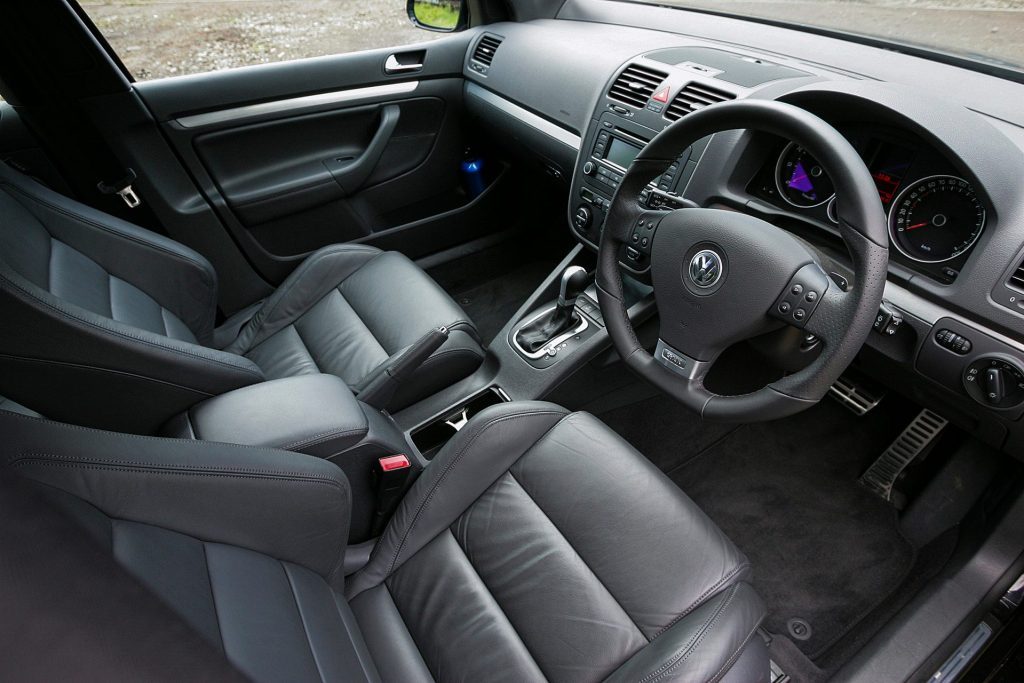
Both have suitable sporting clothes: air dams, skirts and spoilers. The RS225 is identifiable by the grille that hides the intercooler, and fog lights, while the GTI takes on a deep honeycomb grille with a red frame.
As described earlier, the cabins have had some effort injected into them, but as per, the Golf interior eclipses the Mégane when it comes to the quality of fit and finish and that milled-from-granite feeling.
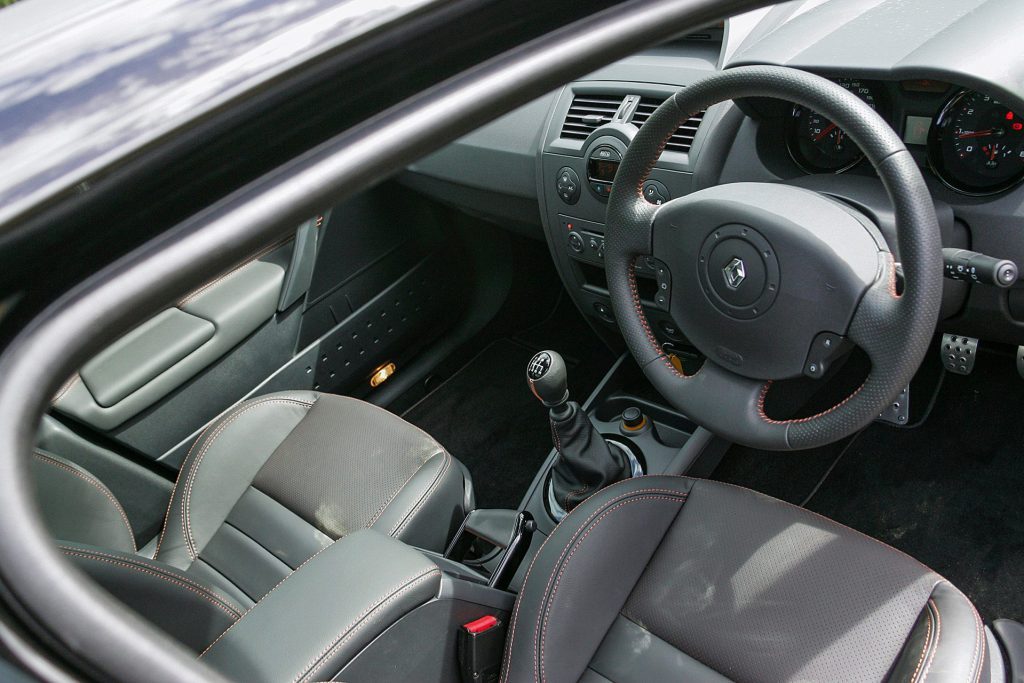
Performance
If you’re after the dragster of the two, it’s the Renault. With more ponies and less weight, that’s a given. Neither car gets off the line particularly well. The Renault is hamstrung by its nagging ESP system. Slip the clutch with a few revs dialled in and the wheels spin, causing a reactivation of the traction control. Power and momentum are snuffed – just enough to make it frustrating. Given the ability to launch, the RS225 would be kicking out a low six-second 0-100km/h time, but has to make do with a fairly reasonable 6.63.
It’s enough to see off the Golf, however. It too fails to make any real momentum straight off the line. The DSG requires a deft touch to extract its best. Stomping on the gas equals wheelspin city, and you can’t hold the DSG back on the brake like a regular auto as the clutches just don’t like it. Instead, you must gently cover the brake and try and get the clutch to slip a little to get a fast take-off. Get it right and you’ll be close to the claimed 6.9s time. We got a best 7.1s run after more than a few attempts.
And the RS225 is quicker also in the 80-120km/h overtaking move, with a 4.66s pass, but the Golf’s quick-shifting DSG claws some ground back with a 4.85s time.
Both have good stoppers and tyres, recording emergency stops from 100km/h under 35 metres.
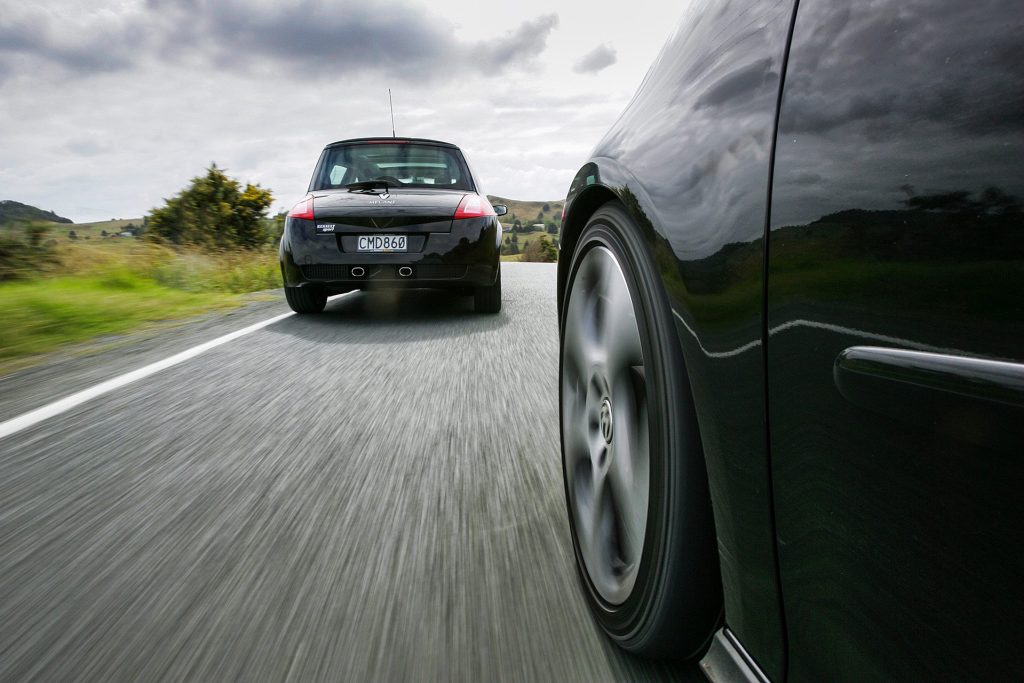
Driving Dynamics
These cars make do with electric steering but the VW engineers have done the better job of tuning their set-up. It’s not perfect, it still is loath to reveal the road, but it’s direct and solidly weighted. A lot like a trophy girlfriend, the steering wheel is beautiful to look at it, great to hold but is hard to engage in a challenging discussion. The Renault’s is a letdown, full of constantly changing artificial weighting; it’s light around town but remote at speed.
It’s a reality with which we must live: front-wheel-drive cars will succumb to understeer, especially those with turbos. More softly sprung and with less aggressive sway bars, the Renault will lean over more and is quicker to slide its nose wide in the corner. The cars both ride on similarly wide tyres but the Golf displays AWD-like grip and poise in the twists. Sling the GTI in hot and the grip up front surprises. It squeals into understeer but give it more lock, and it does well to keep its line. The Volkswagen will succumb to understeer but lets you force the issue determinedly. It displays superior traction and will drive out of corners on the power. Reggie is left scrambling in the tight, the power overwhelms the tyres, the ESP is on duty – and the Golf is gone.
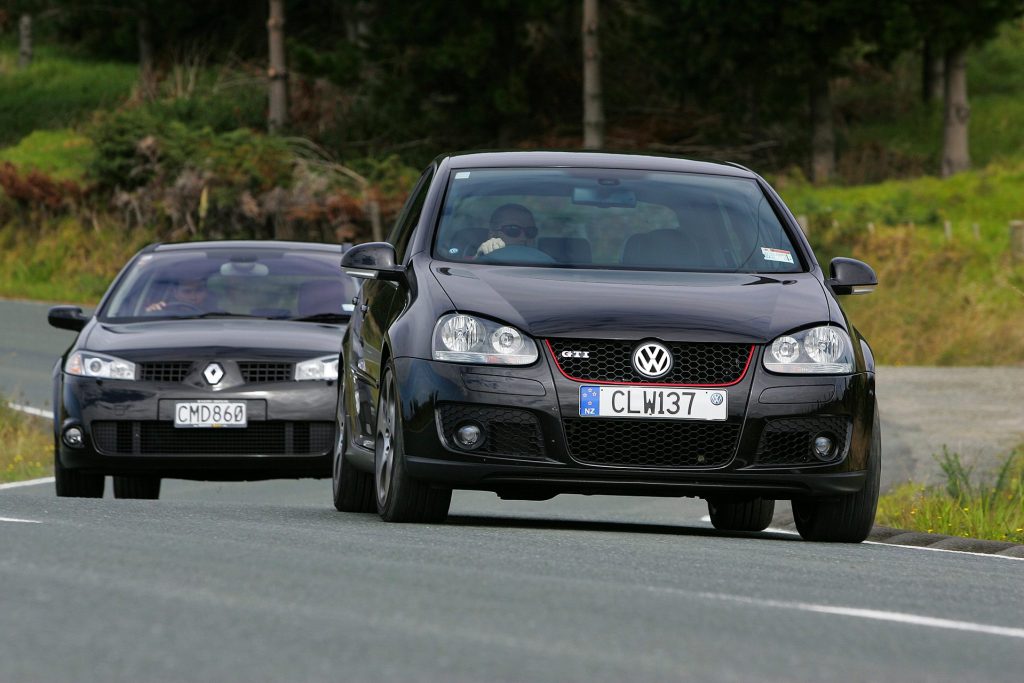
The RS225’s overzealous ESP is too quick to call a halt to play where the Golf’s is liberal. It allows more slip, letting you turn it in harder, and won’t kill the power as quickly when the tractive effort is overcome by those always-on-tap newtons. Both systems are quickly in action when the back starts to step out. And speaking of the rear, the ability of the multlink-equipped VW to deal with bumps gives it a locked-to-the-road feel where Reggie squirms about. In the dry, the GTI wouldn’t be shamed by a WRX on a demanding road.
Apart from its unwillingness to let rip with a quick launch, the DSG is still the one when it comes to spirited driving. Whether it’s left in ‘sport’ or you take control with the paddles, the box delivers the desired ratio quick smart. The Renault’s box is notch-free but imprecise. The brake pedal of the GTI has an inch of spongy play before the brakes will actually start biting. A fair amount of pressure is needed to arrest speed; they work but aren’t confidence-inspiring. The Brembos bolted up to the Renault do the job but are switch-like in operation, and don’t show the same fade resistance of other Brembo set-ups we’ve sampled.
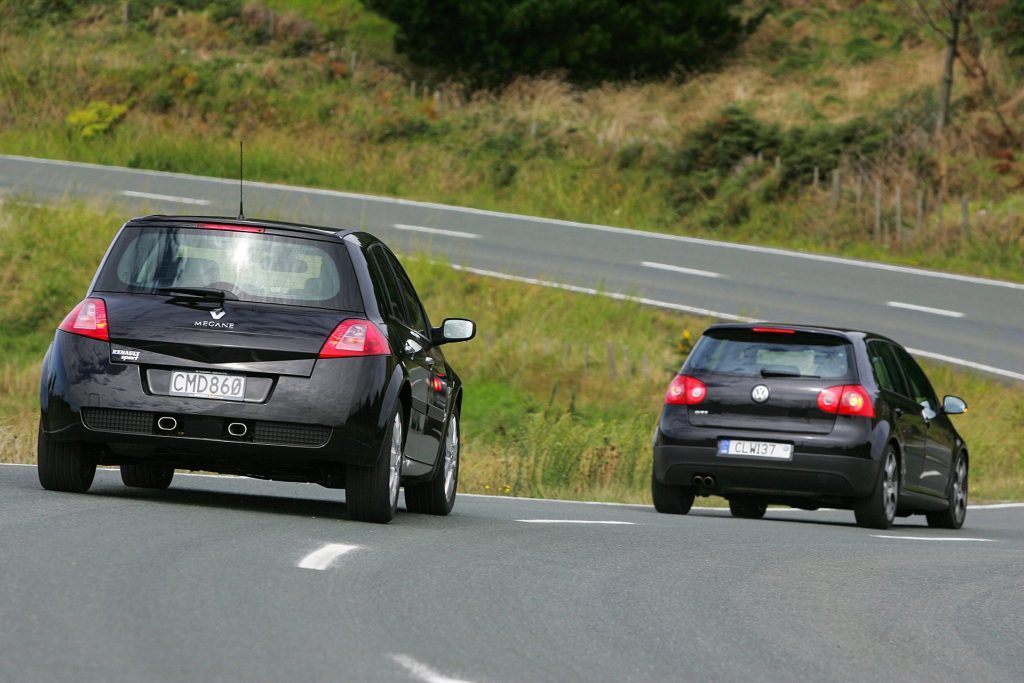
Comfort/Convenience
Ride quality is always a concern when dealing with sportsters. No real worries with these two. The Golf rides well for such a tight-handling car. Some harshness around town is expected but it’s bettered by the Mégane, however, which is supple over most road surfaces. It is also goes without the road rumble of the Golf. There’s a constant intruding din in the VW’s cabin at speed that the Renault does without, making it the more pleasant motorway cruiser.
Both New Zealand distributors have opted for the five-door model variants, going for practicality over show. The Golf is more accommodating in the rear, with more room and a comfier squab. Looking further back, the regular shape of the GTI’s rump makes for a better-shaped boot offering more luggage capacity.
| Model | Renault Megane RS225 |
| Price | $49,990 |
| Engine | 1998cc, IL4, T, |
| Power | 165kW/300Nm |
| Drivetrain | 6-speed manual, FWD |
| Fuel Use | 8.8L/100km |
| 0-100km/h | 6.63sec |
| Weight | 1413kg |
| Model | VW Golf GTI |
| Price | $52,990 |
| Engine | 1984cc, IL4, T, DI |
| Power | 147kW/280Nm |
| Drivetrain | 6-speed DSG, FWD |
| Fuel Use | 8.0L/100km |
| 0-100km/h | 7.1sec |
| Weight | 1449kg |
This article first appeared in the May 2005 issue of NZ Autocar Magazine.


